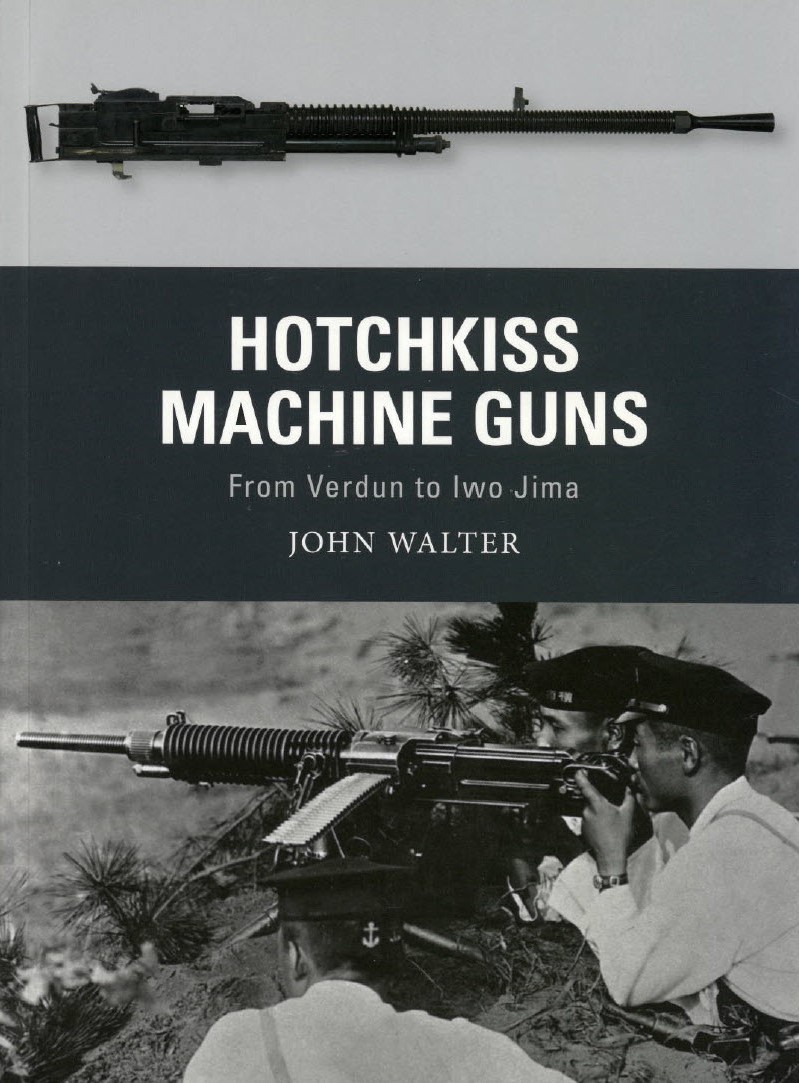Hotchkiss Machine Guns: From Verdun to Iwo Jima
John Walter is among the world's most prolific writers on small arms, and the author of 70 books, translated into more than a dozen languages, and authoritative articles in Guns Digest, Shooter's Bible, and The Armourer. This is John’s first book for Osprey. His next Osprey book in the Weapon series is scheduled for 2020. He lives in East Sussex, UK.
Adam Hook studied graphic design, and began his work as an illustrator in 1983. He specializes in detailed historical reconstructions. Adam has illustrated Osprey titles on subjects as diverse as the Aztecs, the Ancient Greeks, Roman battle tactics, several 19th-century American subjects, the modern Chinese Army, and a number of books in the Fortress series. His work features in exhibitions and publications throughout the world. Adam Hook delivered the battle scene paintings for this book. Check out his web-page at: https://adamhookillustration.com.
Alan Gilliland spent 18 years as the graphics editor of the UK's Daily Telegraph, winning 19 awards in that time. He now writes, illustrates, and publishes fiction, as well as illustrating for a variety of publishers including Osprey. Check him out at https://alangillilandillustration.blogspot.com . Alan Gilliland provided the cut-away illustrations for this volume.
Osprey's 71st book in the Weapon series is a square back soft cover including 80 gloss paper pages. The front cover features a black and white photograph of a 13.2x99 Hotchkiss machine gun introduced in 1930 (from the Royal Armouries collection). The bottom of the front cover features a photograph depicting the predecessor to the Japanese Type 92 machine gun, the Taishio 3rd Year Type machine gun being utilized by the Japanese Navy’s Special Landing Forces. I counted 34 black and white pictures, 38 color photographs, 2 color labeled cut-away illustrations, and 3 color paintings. Adam Hook contributes the three battle-scene color paintings, including two, 2-page spreads. Alan Gilliland provides the labeled color cutaway illustrations of the 8x51mmR Modèle 1900 Hotchkiss gun and the .30-06 Benét-Mercié Machine Rifle M1909.
John Walter kicks off the introduction with a background on machine guns and the environments that led American Benjamin Hotchkiss to his manufacturing facility in 1867 in France. Benjamin Hotchkiss’ revolving cannon was a competitor to the Gatling gun and was quite successful. Although Benjamin would pass in 1885, his company lived on, and acquired the rights to Bohemian Adolf Odkolek’s gas-actuated machine gun. The Maxim machine gun was dominant at the time, but required water cooling. The new Hotchkiss machine gun was air-cooled, making it easier to move. Widely used in WWI by the French, British, and Americans (the Americans referred to it as the Benét-Mercié), the Hotchkiss also found homes in many countries such as Sweden, Norway, Spain, and notably in Japan. The Russo-Japanese War showed the world the power of the machine gun as the Russian Maxims faced the Japanese Hotchkiss machine guns. Japan would continue to develop the Hotchkiss design and use them extensively in WWII. Chinese copies were used in the Korean War, in the French Indochina War, and the Vietnam War. A Turkish Hotchkiss machine gun was recovered in Afghanistan in 2016. The contents include:
- Dedication
- Acknowledgments
- Artist’s Note
- Introduction
- Development – From Revolver Cannon to Machine Gun
- Origins
- Benjamin Hotchkiss [Page 09]
- Enter Odkolek
- Adolf Odokolek
- Hotchkiss Takes Control
- The Modèles 1897 and 1900
- The M1900 Exposed (Color Illustration)
- How Does The Hotchkiss Work?
- The First Successes
- The Hotchkiss and Japan
- French Apathy
- Ammunition
- The Hotchkiss Portative
- The Benét-Mercié Machine Rifle
- The Benét-Mercié Exposed (Color Illustration) [Page 27]
- Japanese Developments
- Use: The Hotchkiss At War
- Japan and China
- The Hotchkiss In The Russo-Japanese War
- The Russo-Japanese War (Color Illustration)
- The Hotchkiss In Mexico
- Tools and Accessories
- The Hotchkiss Enters World War I
- The Hotchkiss M1914
- The Hotchkiss and the Forts
- Mounts [Page 41]
- Crewing and Supply
- The Western Front (Color Illustration)
- The Hotchkiss in the Air [Page 48]
- The First Authenticated Aerial Kill
- The Hotchkiss at Gallipoli
- The British Empire and the Hotchkiss
- The US Hotchkiss in World War I
- After the War: Reparations
- After the War: Japan
- Optical Sights
- Nambu and Hotchkiss: New Designs
- Hotchkiss and the Spanish Civil War
- The Japanese Type 99
- Hotchkiss: The Final Acts
- Impact: A Ground-Breaking Weapon
- Assessing the Hotchkiss
- War in the Pacific (Color Illustration) [Page 71]
- New Developments
- Conclusion
- Bibliography
- Index
I was surprised to learn that Hotchkiss manufactured the Swedish 6.5mm Kulspruta M/1900 machine gun, which was based on the Hotchkiss Mle’95. These apparently became available to be used later in the Mexican Revolution once the Swedish army adopted the water-cooled Schwarzlose as their primary machine gun.
I really appreciated the structure that Osprey’s Weapon series utilizes, starting with the origin of the selected weapon and the following discussion on its development, operational use, and finally a summary of its effectiveness in the ‘Conclusion’ chapter. John Walter provides a very readable text with plenty of photographs that support the storyline. The labeled cutaway illustrations provide insight into the machine gun’s operation through Alan Gilliland’s full-color illustrations. Adam Hook’s color paintings put you into the battle in three different eras. I was able to read the book easily over two evenings. If you own one of the previous releases in the Weapon series, you know what you are getting. If this is your initial entry into this series, you will be quite pleased.
My thanks to Osprey Publishing and IPMS/USA for the chance to review this great book.
Highly recommended!









Comments
Add new comment
This site is protected by reCAPTCHA and the Google Privacy Policy and Terms of Service apply.
Similar Reviews